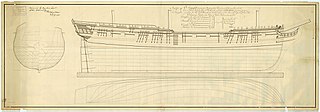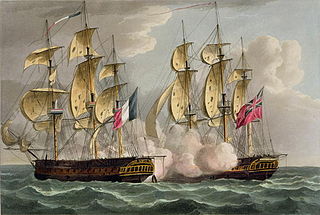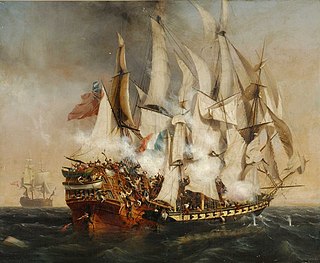Related Research Articles

HMS Indefatigable was one of the Ardent-class 64-gun third-rate ships-of-the-line designed by Sir Thomas Slade in 1761 for the Royal Navy. She was built as a ship-of-the-line, but most of her active service took place after her conversion to a 44-gun razee frigate. She had a long career under several distinguished commanders, serving throughout the French Revolutionary Wars and the Napoleonic Wars. She took some 27 prizes, alone or in company, and the Admiralty authorised the issue of four clasps to the Naval General Service Medal in 1847 to any surviving members of her crews from the respective actions. She was broken up in 1816.
Ten ships of the Royal Navy have been named HMS Pandora after the mythological Pandora. Another was planned, but the name was reassigned to another ship:
Sixteen ships of the Royal Navy have borne the name HMS Wolf or HMS Woolf, after the mammal the wolf:

Eighteen ships of the Royal Navy have borne the name HMS Mercury, or HMS Mercure, after the God Mercury, of Roman mythology:

Révolutionnaire, was a 40-gun Seine-class frigate of the French Navy, launched in May 1794. The British captured her in October 1794 and she went on to serve with the Royal Navy until she was broken up in 1822. During this service Revolutionnaire took part in numerous actions, including three for which the Admiralty would in 1847 award clasps to the Naval General Service Medal, and captured several privateers and merchant vessels.
Fifteen ships of the Royal Navy have borne the name HMS Mary:

Pomone was a 40-gun frigate of the French Navy, launched in 1785. The British captured her off the Île de Batz in April 1794 and incorporated her into the Royal Navy. Pomone subsequently had a relatively brief but active career in the British Navy off the Atlantic and Mediterranean coasts of France before suffering sufficient damage from hitting a rock to warrant being taken out of service and then broken up in 1803.
HMS Niemen was a Royal Navy 38-gun fifth-rate frigate. She began her career as the Niémen, a 44-gun French Navy Armide-class frigate, designed by Pierre Rolland. She was only in French service for a few months when in 1809 she encountered some British frigates. The British captured her and she continued in British service as Niemen. In British service she cruised in the Atlantic and North American waters, taking numerous small American prizes, some privateers but mostly merchantmen. She was broken up in 1815, at the end of the Napoleonic Wars and the War of 1812.

HMS Hazard was a 16-gun Royal Navy Cormorant-class ship-sloop built by Josiah & Thomas Brindley at Frindsbury, Kent, and launched in 1794. She served in the French Revolutionary Wars and throughout the Napoleonic Wars. She captured numerous prizes, and participated in a notable ship action against the French frigate Topaze, as well as in several other actions and campaigns, three of which earned her crew clasps to the Naval General Service Medal. Hazard was sold in 1817.

HMS Unicorn was a 32-gun fifth-rate Pallas-class frigate of the Royal Navy, launched in 1794 at Chatham. This frigate served in both the French Revolutionary Wars and the Napoleonic Wars, including a medal action early in her career. She was broken up in 1815.

Armide was a 40-gun frigate of the French Navy, lead ship of her class, and launched in 1804 at Rochefort. She served briefly in the French Navy before the Royal Navy captured her in 1806. She went on to serve in the Royal Navy until 1815 when she was broken up.
His Majesty's Hired armed lugger Duke of York served the Royal Navy from 14 October 1794 to 2 January 1799 when she foundered in the North Sea. She was of 5744⁄94 tons (bm) and was armed with eight 4-pounder guns.
At least two vessels known as His Majesty's hired armed lugger Nile served the Royal Navy during the French Revolutionary and Napoleonic Wars. These may have been the same vessel on sequential contracts.

HMS Clyde was a Royal Navy Artois-class frigate built at Chatham Dockyard of fir, and launched in 1796. In 1797, she was one of only two ships whose captains were able to maintain some control over their vessels during the Nore mutiny. In 1805, HMS Clyde was dismantled and rebuilt at Woolwich Dockyard; she was relaunched on 23 February 1806. She was ultimately sold in August 1814.
Numerous French naval vessels have borne the name Résolue, the French for "Resolute", as have several privateers.

Résistance was a 48-gun Vengeance-class frigate of the French Navy. HMS St Fiorenzo captured her in 1797 and the Royal Navy took her into service as HMS Fisgard. She was sold in 1814.

Confiance, launched in 1797, was a privateer corvette from Bordeaux, famous for being Robert Surcouf's ship during the capture of the British East India Company's East Indiaman Kent. The British Royal Navy captured Confiance in 1805, took her into service under her existing name, and sold her in 1810. Before she was sold, Confiance took part in two notable actions.
Sorcière was the name of several privateers that sailed during the Napoleonic Wars. Three were French vessels, but one was British, though the British Sorciere was probably the Sorcière launched in 1803 at Saint-Malo that the British Royal Navy captured in April 1806.
HMS Growler was a Archer-class gun-brig built for the British Royal Navy and launched in 1804. She captured several French privateers and one Danish privateer, and took part in two actions that earned her crew the Naval General Service Medal (NGSM). She was sold in 1815.
HMS Conflict was launched in 1805. She captured a number of vessels, including privateers, and participated in several major actions. She disappeared in November 1810 with the loss of all her crew.
References
- ↑ "No. 15322". The London Gazette . 23 December 1800. p. 1438.
- ↑ "Register of Letters of Marque against France 1793-1815". Archived from the original on 9 July 2015. Retrieved 27 June 2011.